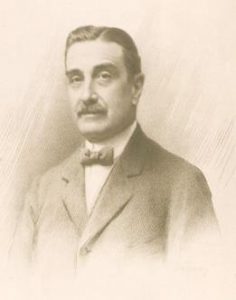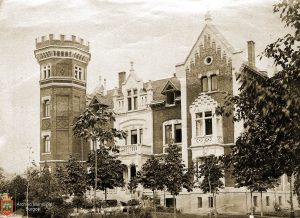Source: “Historia del Palacio de la Isla de Burgos (1883-12010)” de Isaac Rilova Pérez
The Muguiro name is located in Navarra. Fermín Muguiro y Azcárate Iribarren y Suescun, acquired the title of Count on April 4, 1878. The union between Juan Muguiro Iriarte and Benita Cerragería and Gallo-Alcántara, a native of Santander, gave rise to the birth of Francisca Muguiro y Cerragería. And from the marriage between Juan José Muguiro and Iriarte and María Antonia Casi y López, Juan Muguiro y Casi was born.

Juan Muguiro y Casi was the youngest of five children, born in San Sebastian on June 16, 1853. He studied law, but worked as a banker all his life. He was appointed “Gentleman of the Chamber” of His Majesty King Alfonso XIII, on 22 January 1892, for having welcomed his Majesties and Highnesses to the “Palacio de la Isla” on the occasion of their visit to Burgos, following the railway accident in Quintanilleja the previous year. He belonged to the Conservative Party and died on 14 November 1917.
He married his cousin Francisca Muguiro and Cerragería and they would both carry out the construction of the “Palacio de la Isla” on January 16, 1882 until its complete construction in December of that same year.
The period of the ‘Restoration’, a period of reference in the construction of the Palace, was characterised by the reign of Alfonso XII (1875-1885) and later of Alfonso XIII, and the alternation of the conservative parties of Cánovas and Liberal de Sagasta.
At that time, Burgos experienced a great urban development, which meantthe growth of the population of Burgos.

Already in 1881, Juan Muguiro y Casi started his plans for the construction of the Palace. To this end, the first was the purchase of an estate on the “Paseo de la Isla” owned by María Rojo Ortiz, a widow and native of Burgos. Once the documents of sale were signed, Muguiro’s lawyer, Juan García Sierra, went to the Town Hall to request the building permit, which was granted by the Works Section of the Town Hall in 1882.
On January 16 of the same year, the construction of the building began. At the beginning of December 1883, the construction works were completed. In 1884, work was resumed on the enclosure of the stable walls and depot and in 1885, specifically on 25 November, King Alfonso XII died.